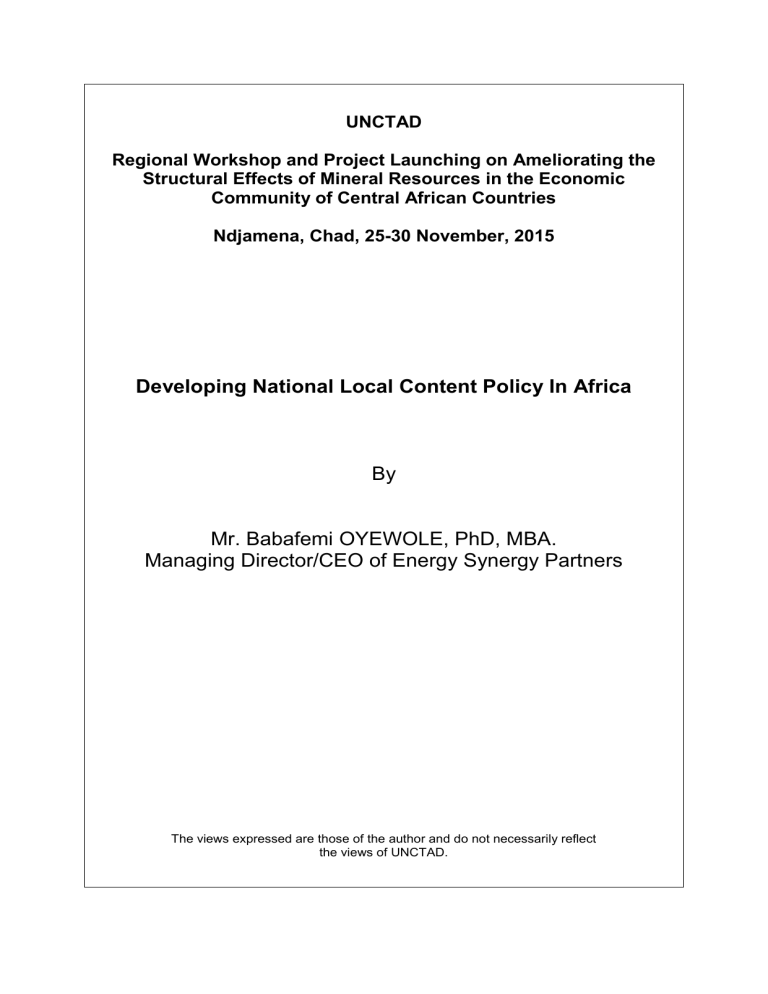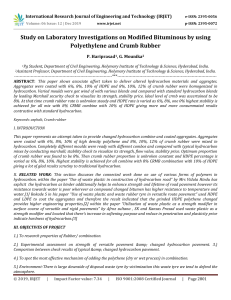UNCTAD Regional Workshop and Project Launching on Ameliorating the

UNCTAD
Regional Workshop and Project Launching on Ameliorating the
Structural Effects of Mineral Resources in the Economic
Community of Central African Countries
Ndjamena, Chad, 25-30 November, 2015
Developing National Local Content Policy In Africa
By
Mr. Babafemi OYEWOLE, PhD, MBA.
Managing Director/CEO of Energy Synergy Partners
The views expressed are those of the author and do not necessarily reflect the views of UNCTAD.
DEVELOPING NATIONAL LOCAL
CONTENT POLICY IN AFRICA.
Presented by
Babafemi OYEWOLE, PhD, MBA.
Managing Director/CEO
Energy Synergy Partners
Presented at a Regional Workshop and Project Launching on
Ameliorating the Structural Effects of Mineral Resources in the Economic Community of Central African Countries,
Ndjamena, Chad, 25-30 November, 2015.
Outline
1. What is Local Content?
2. Why Interest in Local Content?
3. What are the Objectives of Local Content
Policy?
4. What are the Key Elements of Local
Content Policy?
5. What are the Challenges of Developing
Local Content Policy?
6. Concluding Remarks.
1. Introduction: Definition of Local Content
• Generally, local content (LC) is the added value brought to a host nation (and regional and local areas in that country) through the activities of the coal, oil, gas or extractive industry. This may be measured (by project, affiliate, and/or country aggregate) and undertaken through:
– Workforce development: employment of local workforce; and training of local workforce.
– Investments in supplier development: developing supplies and services locally; and procuring supplies and services locally.
• Some see LC in the hydrocarbon sector as local ownership, control and financing by citizens of a nation, in the sector that promotes and enables the optimal use of in‐country human resources, materials and services .
1. Definition of Local Content contd.
• It is value addition leading to sustainable development and culminating also in job creation, economic growth, environmental protection and long-term gains.
Thus, developing local economies, stimulating local industrial development, increasing local capability, building a local skilled workforce and creating a competitive supplier have become the minimum requirements for doing business with host countries and national companies.
2. Why Local Content Development?
• Are major coal, oil and gas discoveries a blessing or curse?
• Norway’s case demonstrates the huge benefits of oil and gas finds.
• To some extent, Botswana’s case shows important blessings from mineral resources wealth.
• However, other African countries’ experiences show how a curse natural resources wealth can be.
• There is huge advantage to have mature institutions in place before hydrocarbon finds.
• Other countries discovering hydrocarbons have to build progress “from scratch”.
2.1 Potential Benefits of Local Content.
Local content
More equipment availability
Increased flexibility
Lower prices
>50% (> min. 15% target)
Expand supply capacity
New suppliers
Strengthen the economy
Create jobs and income
Reinforce internal market
2.3 Growing Global Interest in Local Content Development
2.4 Why the Interest in Local Content Development?
• The interest in local content development policy are:
– Rapid transformation of the hydrocarbon sector for inclusive development and integration of hydrocarbon exploration, production and distribution activities.
– Accelerate growth of indigenous involvement in the hydrocarbon sector.
– Create opportunities for individual citizens to invest in upstream, midstream and downstream hydrocarbon development.
– Enhance the development of national technical and commercial hydrocarbon skills.
– Promote development and poverty reduction by:
• Providing jobs and opportunities for local businesses;
• Facilitating technology transfer; and
• Building local knowledge and skills that are critical for development.
3.0 What are the Objectives of Local Content Policy?
• The objectives of local content policy are to:
– Facilitate increased use of competitive national goods and services
– Expand the commercial co-operation between national and foreign companies
– Strengthen/enhance the sophistication of national financial markets by floating shares in upstream and midstream companies
– To avoid the natural resource curse
– Transformation and visibility of local businesses into world class companies, which can then export their newly acquired competencies
– Significant conservation of foreign exchange reserves
– Development of linkage industries which will support the hydrocarbon sector e.g. steel sector.
4.0 Key Elements of Local Content Policy
4.1 Key Elements in National Local Content Development contd
4.2 Experiences in National Local Content Development.
4.3 Lessons from National Experiences in Local
Content Development.
5.0 Challenges of National Local Content Development.
The challenges of developing national local content policy are:
• Limited local content capability-Local entrepreneurs are not competitive in price/quality/technical competence
• Access to capital equipment
• Reluctance by investors to assist local content companies
• Perception that local content participation is based on commissions, not as a value-adding activity
• Most local firms lack experience, financial track record and the quality systems required
• High minimum capital requirements – a challenge
• Breaking into the global supply chain is difficult
• Believe that their greatest deficiencies are technical
• International companies have identified business and management practices as the main challenge
• Financing Challenges
– Limited local funding capacity
– Short tenors relative to requirements
– High cost of local borrowing
– Limited access to international financing
6.0 Concluding Remarks.
Local content is gaining currency globally particularly in developing countries because it is considered as a strategy to increase the value-added of the exploitation of mineral resources to the socioeconomic development of mineral producing countries. It is also seen as a mechanism for enhancing employment generation and the effective development of the different aspects of mineral sector value chain in the economies.
To achieve effective local content development policy, there is the need for appropriate government support, friendly investment climate, availability of financial resources and the implication of the relevant stakeholders such as the private sector enterprises and the civil society to ensure their commitment to the implementation of the policy.







